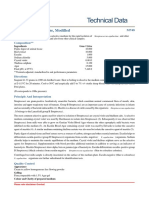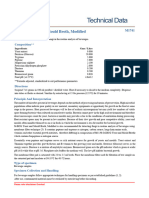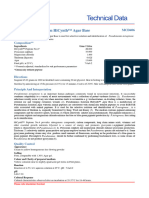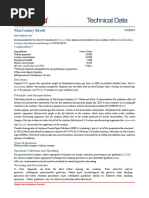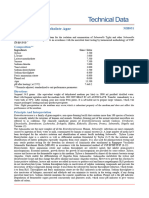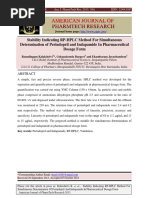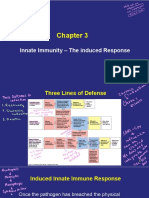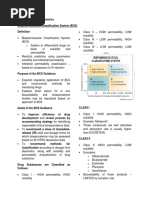EMB Agar: Composition Intended Use
EMB Agar: Composition Intended Use
Uploaded by
AbdulrahmanCopyright:
Available Formats
EMB Agar: Composition Intended Use
EMB Agar: Composition Intended Use
Uploaded by
AbdulrahmanOriginal Title
Copyright
Available Formats
Share this document
Did you find this document useful?
Is this content inappropriate?
Copyright:
Available Formats
EMB Agar: Composition Intended Use
EMB Agar: Composition Intended Use
Uploaded by
AbdulrahmanCopyright:
Available Formats
EMB Agar M317
Intended Use:
Recommended for differential isolation of Gram-negative enteric bacilli from clinical and non-clinical specimens.
Composition**
Ingredients Gms / Litre
Peptone 10.000
Dipotassium hydrogen phosphate 2.000
Lactose 5.000
Saccharose (Sucrose) 5.000
Eosin - Y 0.400
Methylene blue 0.065
Agar 13.500
Final pH ( at 25°C) 7.2±0.2
**Formula adjusted, standardized to suit performance parameters
Directions
Suspend 35.96 grams in 1000 ml purified / distilled water. Mix until suspension is uniform. Heat to boiling to dissolve
the medium completely. Sterilize by autoclaving at 15 lbs pressure (121°C) for 15 minutes. AVOID OVERHEATING. Cool
to 45-50°C and shake the medium in order to oxidize the methylene blue (i.e. to restore its blue colour) and to suspend the
flocculent precipitate.(If EMB Agar is inoculated on the same day, it may be used without autoclave sterilization).
Precaution : Store the medium away from light to avoid photooxidation
Principle And Interpretation
Eosin Methylene Blue (EMB) Agar was originally devised by Holt-Harris and Teague (2) and further modified by Levine
(6). The above medium is a combination of the Levine and Holt-Harris and Teague formulae which contains
peptone and phosphate as recommended by Levine and two carbohydrates as suggested by Holt-Harris
and Teague. Methylene blue and Eosin-Y inhibit gram-positive bacteria to a limited degree. These dyes serve as
differential indicators in response to the fermentation of carbohydrates. The ratio of eosin and methylene blue is
adjusted approximately to 6:1. Sucrose is added to the medium as an alternative carbohydrate source for typically
lactose-fermenting, gram-negative bacilli, which on occasion do not ferment lactose or do so slowly. The coliforms
produce purplish black colonies due to taking up of methylene blue-eosin dye complex, when the pH drops. The dye
complex is absorbed into the colony. Nonfermenters probably raise the pH of surrounding medium by oxidative
deamination of protein, which solubilizes the methylene blue-eosin complex resulting in colourless colonies (3). Some
strains of Salmonella and Shigella species do not grow in the presence of eosin and methylene blue. Further tests are
required to confirm the isolates.
Peptone serves as source of carbon, nitrogen, and other essential growth nutrients. Lactose and sucrose are the sources
of energy by being fermentable carbohydrates. Eosin-Y and methylene blue serve as differential indicators. Phosphate
buffers the medium.
The test sample can be directly streaked on the medium plates. Inoculated plates should be incubated, protected from light.
However standard procedures should be followed to obtain isolated colonies. A non-selective medium should be inoculated
in conjunction with EMB Agar. Confirmatory tests should be further carried out for identification of isolated colonies.
Type of specimen
Clinical samples- Faecal samples, Food samples, Water samples
Specimen Collection and Handling
For clinical samples follow appropriate techniques for handling specimens as per established guidelines (4,5).
For food samples, follow appropriate techniques for sample collection and processing as per guidelines (7).
For water samples, follow appropriate techniques for sample collection, processing as per guidelines and local standards.(1)
After use, contaminated materials must be sterilized by autoclaving before discarding.
Warning and Precautions
In Vitro diagnostic use. Read the label before opening the container. Wear protective gloves/protective clothing/eye
protection/face protection. Follow good microbiological lab practices while handling specimens and culture. Standard
Please refer disclaimer Overleaf.
HiMedia Laboratories Technical Data
precautions as per established guidelines should be followed while handling clinical specimens. Safety guidelines may be
referred in individual safety data sheets.
Limitations :
1. Individual organisms differ in their growth requirement and may show variable growth patterns on the medium.
2.Each lot of the medium has been tested for the organisms specified on the COA. It is recommended to users to validate
the medium for any specific microorganism other than mentioned in the COA based on the user’s unique requirement.
3.Confirmatory tests should be further carried out for identification of isolated colonies.
Performance and Evaluation
Performance of the medium is expected when used as per the direction on the label within the expiry period when
stored at recommended temperature.
Quality Control
Appearance
Light pink to purple homogeneous free flowing powder
Gelling
Firm, comparable with 1.35% Agar gel.
Colour and Clarity of prepared medium
Reddish purple coloured, opalescent gel with greenish cast and finely dispersed precipitate forms in Petri plates
Reaction
Reaction of 3.6% w/v aqueous solution at 25°C. pH : 7.2±0.2
pH
7.00-7.40
Cultural Response
Cultural characteristics observed after an incubation at 35 - 37°C for 18 - 24 hours
Organism Inoculum Growth Recovery Colour of
(CFU) colony
# Klebsiella aerogenes 50-100 good 40-50% pink, without
ATCC 13048 (00175*) sheen
Escherichia coli ATCC 50-100 luxuriant >=50% purple with
25922 (00013*) black centre
and green
metallic sheen
Klebsiella pneumoniae 50-100 good 40- 50% pink, mucoid
ATCC 13883 (00097*)
Proteus mirabilis ATCC 50-100 luxuriant >=50% colourless
25933
Salmonella Typhimurium 50-100 luxuriant >=50% colourless
ATCC 14028 (00031*)
Staphylococcus aureus >=104 inhibited 0%
subsp. aureus ATCC
25923 (00034*)
Key : (*) Corresponding WDCM numbers. (#) Formerly known as Enterobacter aerogenes
Storage and Shelf Life
Store between 10-30°C in a tightly closed container and the prepared medium at 20-30°C. Use before expiry date on
the label. On opening, product should be properly stored dry, after tightly capping the bottle in order to prevent lump
formation due to the hygroscopic nature of the product. Improper storage of the product may lead to lump formation.
Store in dry ventilated area protected from extremes of temperature and sources of ignition. Seal the container
tightly after use. Product performance is best if used within stated expiry period.
Disposal
User must ensure safe disposal by autoclaving and/or incineration of used or unusable preparations of this product. Follow
established laboratory procedures in disposing of infectious materials and material that comes into contact with clinical
sample must be decontaminated and disposed of in accordance with current laboratory techniques (4,5).
Please refer disclaimer Overleaf.
HiMedia Laboratories Technical Data
Reference
1. Baird R.B., Eaton A.D., and Rice E.W., (Eds.), 2015, Standard Methods for the Examination of Water and Wastewater,
23rd ed., APHA, Washington, D.C.
2. Holt-Harris and Teague,1916, J. Infect. Dis., 18 : 596.
3. Howard B.J., 1994, Clinical and Pathogenic Microbiology, 2nd ed., Mosby Year Book, Inc.
4. Isenberg (Eds.), 1992, Clinical Microbiology Procedures Handbook, Vol . 1, American Society for Microbiology,
Washington, D.C.
5. Jorgensen, J.H., Pfaller, M.A., Carroll, K.C., Funke, G., Landry, M.L., Richter, S.S and Warnock., D.W. (2015) Manual of
Clinical Microbiology, 11th Edition. Vol. 1.
6. Levine, 1918, J. Infect. Dis., 23:43.
7. Salfinger Y., and Tortorello M.L. Fifth (Ed.), 2015, Compendium of Methods for the Microbiological Examination of
Foods, 5th Ed., American Public Health Association, Washington, D.C.
Revision : 02/ 2020
In vitro diagnostic medical
IVD device
CE Marking
30°C Storage temperature
10°C
Do not use if package
is damaged
HiMedia Laboratories Pvt. Limited,
23 Vadhani Industrial Estate, LBS
Marg,Mumbai-86,MS,India
CE Partner 4U ,Esdoornlaan 13, 3951
EC REP
DB Maarn The Netherlands,
www.cepartner 4u.eu
Disclaimer :
User must ensure suitability of the product(s) in their application prior to use. Products conform solely to the information contained in
this and other related HiMedia™ publications. The information contained in this publication is based on our research and development
work and is to the best of our knowledge true and accurate. HiMedia™ Laboratories Pvt Ltd reserves the right to make changes to
specifications and information related to the products at any time. Products are not intended for human or animal or therapeutic use but
for laboratory,diagnostic, research or further manufacturing use only, unless otherwise specified. Statements contained herein should not
be considered as a warranty of any kind, expressed or implied, and no liability is accepted for infringement of any patents.
HiMedia Laboratories Pvt. Ltd. Reg.office : 23, Vadhani Ind.Est., LBS Marg, Mumbai-400086, India. Customer care No.: 022-6116 9797 Corporate office :
A-516,Swastik Disha Business Park,Via Vadhani Ind. Est., LBS Marg, Mumbai-400086, India. Customer care No.: 022-6147 1919 Email:
techhelp@himedialabs.com Website: www.himedialabs.com
You might also like
- Determination Citric Acid in Fruit JuiceDocument7 pagesDetermination Citric Acid in Fruit JuiceJacob Agdon33% (6)
- TDS M317Document3 pagesTDS M317darrendelfinoy9No ratings yet
- Hicrome™ Ecc Selective Agar Base: Intended Use: CompositionDocument3 pagesHicrome™ Ecc Selective Agar Base: Intended Use: Compositionafiifa1015No ratings yet
- M352Document3 pagesM352DBPNo ratings yet
- Urea Broth Base (Diagnostic Stuarts Urea Broth Base) : Intended UseDocument3 pagesUrea Broth Base (Diagnostic Stuarts Urea Broth Base) : Intended Use10605114No ratings yet
- M008SDocument3 pagesM008Sanulorance98No ratings yet
- Lysine Decarboxylase PDFDocument3 pagesLysine Decarboxylase PDFSherly MardianaNo ratings yet
- M1297ADocument3 pagesM1297Ateena jacobNo ratings yet
- TechnicalDocument2 pagesTechnicalnafiw31466No ratings yet
- Sabouraud Dextrose Broth (Sabouraud Liquid Medium) : Intended UseDocument3 pagesSabouraud Dextrose Broth (Sabouraud Liquid Medium) : Intended UseCintya Arum SariNo ratings yet
- CLEDDocument3 pagesCLEDAnita HerreraNo ratings yet
- Technical Data: Hicrome™ Improved Salmonella AgarDocument3 pagesTechnical Data: Hicrome™ Improved Salmonella AgarAbhishek BanerjeeNo ratings yet
- M1255Document3 pagesM1255FERNANDA LEONHARDTNo ratings yet
- Himedia M933Document3 pagesHimedia M933linaNo ratings yet
- Agar EdwardsDocument2 pagesAgar EdwardsGeraldine CacaceNo ratings yet
- ™ Ec O157:H7 Agar, Modified: HicromeDocument3 pages™ Ec O157:H7 Agar, Modified: Hicromediana benites salcedoNo ratings yet
- Peptone Water: Intended Use: CompositionDocument3 pagesPeptone Water: Intended Use: Composition10605114No ratings yet
- MH581Document3 pagesMH581Abid Iqbal ARDNo ratings yet
- M121IDocument2 pagesM121IventyfaniaNo ratings yet
- BETA-SSA Agar (Group A Streptococci Selective Agar)Document3 pagesBETA-SSA Agar (Group A Streptococci Selective Agar)uttam.micro404No ratings yet
- Sabouraud Cycloheximide Chloramphenicol Agar: Intended UseDocument3 pagesSabouraud Cycloheximide Chloramphenicol Agar: Intended UsenadyasantikaNo ratings yet
- Plate Count Agar (Standard Methods Agar) : Intended UseDocument3 pagesPlate Count Agar (Standard Methods Agar) : Intended UsenuraenirianNo ratings yet
- Malt Extract Agar: Intended UseDocument3 pagesMalt Extract Agar: Intended UseMimma MonicaNo ratings yet
- Buffered Peptone Water: Intended UseDocument3 pagesBuffered Peptone Water: Intended UseUlliaNo ratings yet
- Pseudomonas Agar (For Pyocyanin) (In A Accordance With IP 2007)Document2 pagesPseudomonas Agar (For Pyocyanin) (In A Accordance With IP 2007)sezinaltiokkNo ratings yet
- Kovac's Indole Reagent: Intended UseDocument2 pagesKovac's Indole Reagent: Intended UseShamim MahmudNo ratings yet
- M049 (1)Document3 pagesM049 (1)NEHA VAGHELANo ratings yet
- Blood Agar Base (Infusion Agar) : Intended UseDocument3 pagesBlood Agar Base (Infusion Agar) : Intended UseJohnree A. EvangelistaNo ratings yet
- Luria Bertani Agar, Miller (Miller Luria Bertani Agar) : Intended UseDocument2 pagesLuria Bertani Agar, Miller (Miller Luria Bertani Agar) : Intended Usecrazyknowledge10No ratings yet
- TDS GM108Document4 pagesTDS GM108florengrace.fg98No ratings yet
- M-BCG Yeast and Mould Broth, Modified: Intended UseDocument3 pagesM-BCG Yeast and Mould Broth, Modified: Intended UseWilliamNo ratings yet
- MP5332Document3 pagesMP5332satyen.ghosh1111No ratings yet
- Technical Data: Plate Count Agar (Standard Methods Agar)Document2 pagesTechnical Data: Plate Count Agar (Standard Methods Agar)பொ.தெய்வராஜன்No ratings yet
- Malonate Broth PDFDocument2 pagesMalonate Broth PDFSherly MardianaNo ratings yet
- Nutrient Agar 2Document3 pagesNutrient Agar 2Khaza VinodNo ratings yet
- Inserto HimediaDocument3 pagesInserto HimediayyewelsNo ratings yet
- M121IDocument2 pagesM121INEHA VAGHELANo ratings yet
- Pseudomonas Isolation HiCynth™ Agar BaseDocument2 pagesPseudomonas Isolation HiCynth™ Agar Baseuttam.micro404No ratings yet
- TDS M1079Document3 pagesTDS M1079darren.smartlabNo ratings yet
- MB PDFDocument3 pagesMB PDFARATHY M NAIR 2147718No ratings yet
- M001 PDFDocument3 pagesM001 PDFkeresahanmuNo ratings yet
- 2. R008 Kovac'sDocument3 pages2. R008 Kovac'sirvanNo ratings yet
- BHI BrothDocument3 pagesBHI BrothHà Anh Minh LêNo ratings yet
- MH031 Xylose-Lysine-Deoxycholate Agar, HarmonizedDocument4 pagesMH031 Xylose-Lysine-Deoxycholate Agar, Harmonizedtogapn470No ratings yet
- Methyl Red Indicator: Intended Use: CompositionDocument2 pagesMethyl Red Indicator: Intended Use: CompositionAli HamzaNo ratings yet
- Violet Red Bile Agar: CompositionDocument2 pagesViolet Red Bile Agar: CompositionMuhammad AdnanNo ratings yet
- Chloran Rose Bengal Chloramphenicol Agar (DRBC Agar) : Intended UseDocument3 pagesChloran Rose Bengal Chloramphenicol Agar (DRBC Agar) : Intended Useபொ.தெய்வராஜன்No ratings yet
- Broth: Intended UseDocument3 pagesBroth: Intended UseRaga PreethikaNo ratings yet
- Hektoen MIBIODocument2 pagesHektoen MIBIOHuỳnh Nguyễn TrúcNo ratings yet
- Eosin Methylene Blue Agar (EMB) : IndustryDocument2 pagesEosin Methylene Blue Agar (EMB) : Industrysigit the pembalapNo ratings yet
- M108DDocument3 pagesM108Dadrijaamukherjee27No ratings yet
- Clostridial Agar: Intended UseDocument3 pagesClostridial Agar: Intended Usesg.comNo ratings yet
- Mitis Salivarius Agar Base: CompositionDocument2 pagesMitis Salivarius Agar Base: CompositionAbid SiddiquiNo ratings yet
- Technical Data: Peptone WaterDocument3 pagesTechnical Data: Peptone WaterAbdulrahmanNo ratings yet
- Buffered Peptone Water, GranulatedDocument3 pagesBuffered Peptone Water, GranulateduttamNo ratings yet
- MM242Document3 pagesMM242Anand H SNo ratings yet
- Conda Lab Dextrose Sabouraud 1024 - en - 3Document2 pagesConda Lab Dextrose Sabouraud 1024 - en - 3Natália DiasNo ratings yet
- Lacto Phenol Cotton Blst nDocument4 pagesLacto Phenol Cotton Blst nprateekNo ratings yet
- Corn Meal Agar: Intended UseDocument2 pagesCorn Meal Agar: Intended Usealbdanyghmdan609No ratings yet
- Tryptic Soya Agar: Intended UseDocument2 pagesTryptic Soya Agar: Intended UseGopi NathNo ratings yet
- Datasheet Seriesdzplainbearing2cwheels 13136 13136 - en 638428082957987393 1707217815Document1 pageDatasheet Seriesdzplainbearing2cwheels 13136 13136 - en 638428082957987393 1707217815AbdulrahmanNo ratings yet
- Certification: Performance TestedDocument7 pagesCertification: Performance TestedAbdulrahmanNo ratings yet
- Storage / Stability Sample Material / Sample EnrichmentDocument4 pagesStorage / Stability Sample Material / Sample EnrichmentAbdulrahmanNo ratings yet
- Product Information Sheet SALXDocument1 pageProduct Information Sheet SALXAbdulrahmanNo ratings yet
- MacConkey Agar Plates ProtocolsDocument4 pagesMacConkey Agar Plates ProtocolsAbdulrahmanNo ratings yet
- Physical Sciences P2 2021 - 0Document16 pagesPhysical Sciences P2 2021 - 0dimphomanganye818No ratings yet
- Organic Chemistry Some Basic Principles and Techniques (GOC)Document3 pagesOrganic Chemistry Some Basic Principles and Techniques (GOC)Patel OmNo ratings yet
- 02 Atomic Structure and Interatomic BondingDocument76 pages02 Atomic Structure and Interatomic BondingNorell TolentinoNo ratings yet
- Oil RefiningDocument13 pagesOil RefiningRavindra AgarwalNo ratings yet
- sdfsdfweDocument2 pagessdfsdfweAcadGucciManeNo ratings yet
- Stability Indicating RP-HPLC Method For Simultaneous Determination of Perindopril and Indapamide in Pharmaceutical Dosage FormDocument9 pagesStability Indicating RP-HPLC Method For Simultaneous Determination of Perindopril and Indapamide in Pharmaceutical Dosage FormBoovizhikannan ThangabalanNo ratings yet
- Chapter 3 PowerPointDocument73 pagesChapter 3 PowerPointJohn NikolaevichNo ratings yet
- Grade 12 November 1st Term Test 2019Document13 pagesGrade 12 November 1st Term Test 2019Piyumi ObeyesekeraNo ratings yet
- Module 1Document19 pagesModule 1ABIGAIL OLAJUMOKE JOSEPHNo ratings yet
- SPHBA - Motorsports Clean Break Couplings enDocument12 pagesSPHBA - Motorsports Clean Break Couplings enAlper SakalsizNo ratings yet
- Ques Blue3 KMKTDocument17 pagesQues Blue3 KMKTfatihah abdullahNo ratings yet
- Chemistry Investigatory Project OnDocument15 pagesChemistry Investigatory Project OnjibinNo ratings yet
- GPB-221 AssignmentDocument8 pagesGPB-221 AssignmentShubham ChauhanNo ratings yet
- Chapter 5 Reacting Masses and Chemical EquationDocument29 pagesChapter 5 Reacting Masses and Chemical Equationchitminthu560345100% (1)
- Quattrocchi - Introduccion A La HPLCDocument405 pagesQuattrocchi - Introduccion A La HPLCdaniel villamizarNo ratings yet
- Solubility and PermeabilityDocument3 pagesSolubility and PermeabilityGNCDWNo ratings yet
- ChromatographyDocument11 pagesChromatographyMr nobody100% (1)
- 4172-Genon-1-14-0002-Specification For Concrete WorksDocument59 pages4172-Genon-1-14-0002-Specification For Concrete WorksRajesh SinghNo ratings yet
- Formaldehyde Production Via Vapour Phase Dehydrogenaytion of Methanol Using Silver CatalystDocument25 pagesFormaldehyde Production Via Vapour Phase Dehydrogenaytion of Methanol Using Silver Catalystvan1cc1nvNo ratings yet
- Analysis of Antioxidative Phenolic Compounds in ArtichokeDocument8 pagesAnalysis of Antioxidative Phenolic Compounds in ArtichokeAhmet UluadNo ratings yet
- Electrocoagulation-Electroflotation As A Surface Water Treatment For Industrial UsesDocument2 pagesElectrocoagulation-Electroflotation As A Surface Water Treatment For Industrial UsesHayes PaderangaNo ratings yet
- Failure in PolymersDocument45 pagesFailure in PolymersPulak RoyNo ratings yet
- Chapter 6Document17 pagesChapter 6helloblarg100% (3)
- High Performance Trays For A Fractionator - in - A - AromaticsDocument5 pagesHigh Performance Trays For A Fractionator - in - A - AromaticsB rgNo ratings yet
- Santoprene WMG Bulb Seal Case Story en PDFDocument2 pagesSantoprene WMG Bulb Seal Case Story en PDFMarcos Antonio RossiNo ratings yet
- Pearl Questions &answersDocument32 pagesPearl Questions &answersnrendo26No ratings yet
- ChromophoresDocument28 pagesChromophoresangelalee20002No ratings yet
- Contrast Media: Vashist B. Mhalsekar III Year Medical Imaging Technology Goa Medical CollegeDocument33 pagesContrast Media: Vashist B. Mhalsekar III Year Medical Imaging Technology Goa Medical CollegeOmkar GaonkarNo ratings yet
- Overview of Scale-Up and Post-Approval Changes (SUPAC)Document3 pagesOverview of Scale-Up and Post-Approval Changes (SUPAC)Ashwini DoleNo ratings yet















